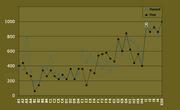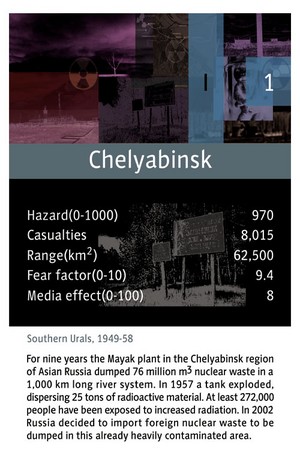|

Mayak Chemical Combine is located near Ozersk, a city in the Southern Urals. The complex itself covers an area of approximately 90 square kilometres and employs 17,000 people.
Prior to 1990 the city was known only by its post office box number Chelyabinsk 40. The reactors began operating in 1948 and produced plutonium for weapons, uranium, heavy and light water. The plutonium produced here was used in Russia�s first atom bomb in 1949.
From 1949 to 1956 76 million m3 liquid radioactive waste was dumped in the Techa river, which is 240 km long and discharges into the river Iset at Dalmatovo. The Iset in turn discharges into the river Tobol, which joins with the river Irtysh, which in turn flows into the river Ob. The Ob drains into the Kara Sea.
The river system is approximately 1,000 kilometres in length. About 272,000 people were exposed to radiation as a result of these discharges and 7,500 residents were evacuated from their villages along the riverside.
On 29 September 1957, a severe contamination took place when one of the tanks exploded, dispersing 25 tons of radioactive material over a 23,000 km2 area. At least 200 people died and 10,200 people were evacuated, but even more villagers stayed in the contaminated areas.
The Kyshtym accident is rated 6 out of a maximum 7 in degree of severity on the International Nuclear Event Scale. In 1967 there was a third dispersal of radioactive waste when one of the lakes used for storage of nuclear waste fell dry during a hot summer and a storm blew nuclear dust across a vast area around Lake Karachay.
Every year, 10 million m3 of liquid radioactive waste are dumped in the water reservoirs along the Techa River. Today, radioactive water is held back from the river system only by a simple rampart, which would easily be torn down by heavy rains.
At the same time, Russia has decided to import 20,000 tons of nuclear waste in exchange for over 20 billion US dollars. Potential exporting countries include Germany, Switzerland, Japan, Hungary and Spain.
In a poll made among the Chelyabinsk population, 99,4 percent believes it is dangerous to live close to the Mayak plant, and two out of three have friends or relatives who suffer from being exposed to radiation. Less than half of the population knows about the plans for storing even more nuclear waste in the region.
Comment this page
 
Links and references:
Death toll calculations from the Russian Ministry of Health are cited here:
http://www.rockymountainnews.com/drmn/world/articl...
The official Mayak plant site:
http://www.jccem.fsu.edu/Partners/MAYAK.cfm
Contamination data from Kyshtym:
http://www.kose.ee/nucbasic/nucpedia/uk/kyshtym.ht...
Read the poll of the Chelyabinsk population:
http://www.bellona.no/en/international/russia/nuke...
Read about the potential disaster:
http://www.bellona.no/en/international/russia/nuke...
Read about Russia�s plan to dump even more radioactive waste:
http://archive.greenpeace.org/mayak/
|

|
|



